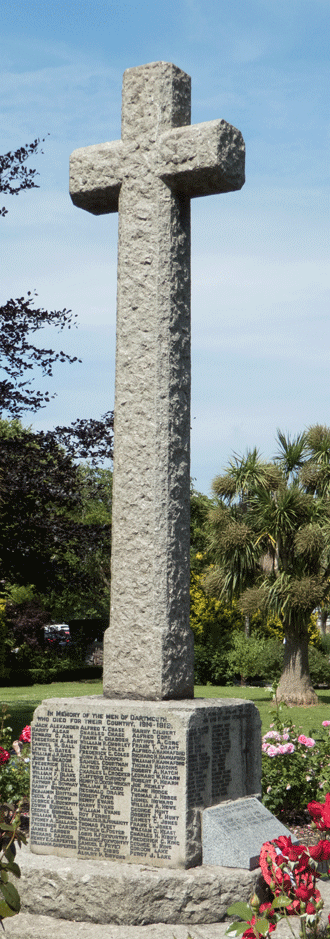Cecil Alfred Brown
Cecil Alfred Brown was born in Dartmouth in 1895 and baptised at St Saviours on 26th September 1895. He was the second child and eldest son of Alfred Samuel Brown and Jane Childs.
Alfred Samuel Brown was born in Dartmouth in 1873. His father, William Charles Brown, like his father and grandfather, was a mariner. He died relatively young, aged 45, in 1887, leaving his wife Elizabeth with seven children to support. She was clearly a woman of some resourcefulness as she opened a grocery shop in Dartmouth, in which several of her children worked at one time or another. Alfred joined the Post Office. As such he became a well-known and well-liked character in the town; he was also active in various clubs and societies.
Alfred married Jane Childs in 1893. Although Jane was born in Lincolnshire, her family was from Slapton. She already had a daughter, Daisy Pauline, aged two. Alfred and Jane soon had a growing family. Apart from Daisy and Cecil, there was:
- Elsie Maud, baptised at St Saviours in 24th June 1894
- Florence Emily, baptised at St Saviours on 3rd February 1898
- Ivy Constance, baptised at St Saviours on 25th March 1900
- Stanley Charles, baptised at St Saviours on 9th November 1902
Tragedy then struck. On 27th November 1904, Alfred died at Dartmouth Cottage Hospital after a short illness. The Dartmouth Chronicle of 2nd December 1904 carried the following pieces:
Every sympathy is felt with Mrs A S Brown and her family in the death of her husband, a postman of some years standing, who died at the Cottage Hospital on Sunday after an illness of a very short duration. Deceased was the honorary secretary of the Dartmouth and District Cycling Club and on Monday evening a largely attended meeting of the club members was held at Lower St, with the captain Mr W Came in the chair, when it was decided to send a wreath and to attend the funeral on Sunday. Rechabites will also be present in full muster, deceased having recently become a member of the local tent. The postal staff intend, on December 16th, to carry out a concert in aid of the widow and family, and on Wednesday next at 6pm on the New Ground, Mr J W Pillar, Britannia Inn, will by permission of the surveyor, run an Alpine Railway and other amusements, the proceeds of which will be devoted to the same object. Mr W L Saunders, Castle Hotel, has kindly offered to place a hearse and coach at the disposal of the family for the funeral.
The editor wrote:
The sad death of Postman Brown has cast quite a gloom over his fellows and the members of the local Cycling Club. He was one of the most popular of the postal staff of Dartmouth, quiet and unassuming in manner, and always ready to do a good turn for anyone, even at personal inconvenience. As a cyclist he was a steady going rider, with no pretensions to scorching or rushing about the roads like a modern John Gilpin. He took over the secretarial duties a year or so ago, and it is not too much to say, with all due respect to secretaries who succeeded him, that he has carried out the duties in a highly successful manner. Indeed I doubt, from my information, that the club ever had a better or more capable official. They will sadly miss him, for he was just getting accustomed to the work and his heart was in it, which is just as important as any brilliancy in ability. He leaves a widow and six children, the eldest of which is not more than 13, to mourn their loss. Not long ago he joined the Hope of the Dart Tent, Independent Order of Rechabites, and his brother members will turn out on Sunday for the funeral, while it may safely be said that both the Postal Staff and the Cycling Club will also muster in full strength to pay him their last token of respect. The Alpine railway and general amusements which Mr J W Pillar will set up on the New Ground on Wednesday for the benefit of the widow and children should be well patronised. A penny ride on the Alpine is great fun, and I hope the pennies will be forthcoming in large numbers.
Alfred's death seems to have been deeply felt by many in the town. The Rechabite Tent returned his joining fees and subscriptions and Exeter District voted £5 to Jane. The Post Office staff put on a fund-raising concert, for the benefit of Jane and the children, held after the funeral, which was "packed to overflowing". The funeral, meanwhile, was a substantial affair. The Dartmouth Chronicle of 9th December 1904 reported:
... a very large attendance at the funeral, in spite of the wretched weather conditions prevailing. Thick rain fell the whole time and the roads were in a miserable state. From the house at Fairfax Place, to Ford Cross, the coffin was borne by relays from the Rechabites, Cycling Club and Postal staff. Then a hearse was requisitioned and from that point, the official bearers were the Postal staff, which included four postmen from Torquay who came specially to show the sympathy of the Torquay office.... All along the route blinds were generally drawn. The interment took place at the Cemetery, the funeral service being conducted by Rev J E Thorpe (Primitive Methodist) who also preached a memorial service at his church in the evening ... There were several beautiful wreaths, which included tokens from the Postal staff, the President of the Dartmouth Cycling Club (Rev F R B Simpson) and the officers and members of the club. The hearse, from the Castle Hotel, and carriages from the same livery stables and from Mr C Cleave, were supplied gratuitously. Mr J Triggs was the undertaker.
Notwithstanding all this, it seems that Jane was unable to provide for the children in Dartmouth, and she left the town. By the time of the 1911 Census, she was working as the cook for retired Major Charles Percy Dean RE, in his house in Yarmouth, on the Isle of Wight. With her, working as the housemaid, was her daughter Elsie. Round the corner, living with Alfred Wheeler and his wife Emmeline, in Yarmouth, was Cecil, who worked as a footman (where is not stated). Pauline was a parlourmaid in the household of Captain Arthur Cecil Hamilton Dean RGA, in Felixstowe, Suffolk.
The three younger children, Florence, 13, Constance, age 11, and Stanley, age 9, were all "inmates" in Mullers Orphan Houses, Ashley Down, Bristol. This was a very large establishment, consisting of five large houses built between 1849 and 1870 by the Prussian evangelist George Muller. It was originally intended for children who had lost both parents and were destitute. However, by the end of the 19thC, children who had lost one parent were admitted, if the surviving parent was not able to manage. Boys were accepted up to age 10, and girls to age 12, subject to satisfactory school and home reports.
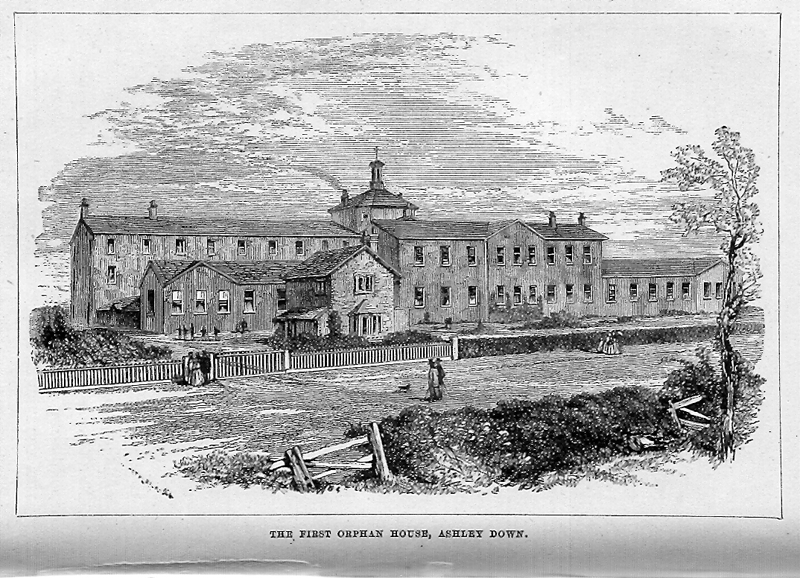
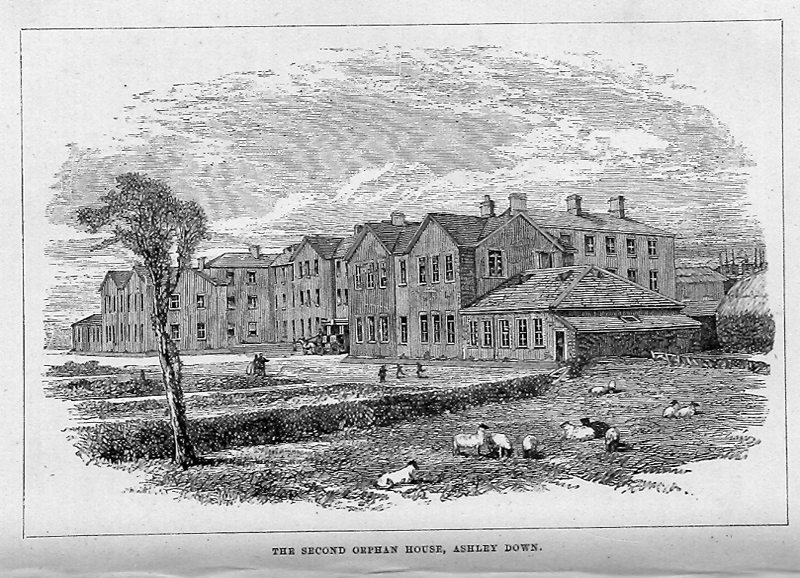
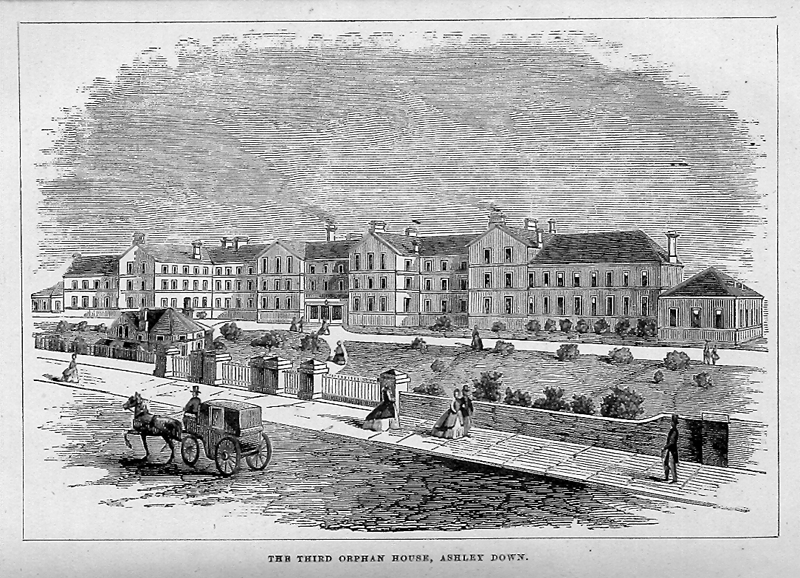
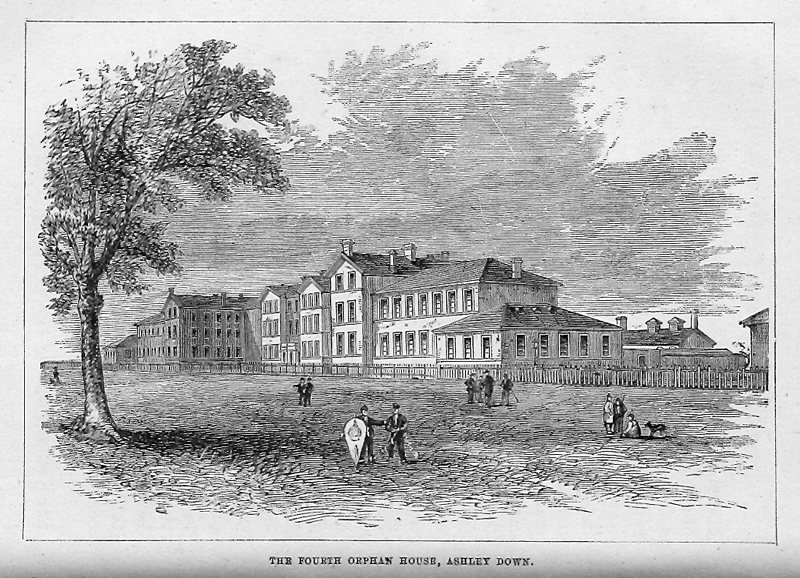
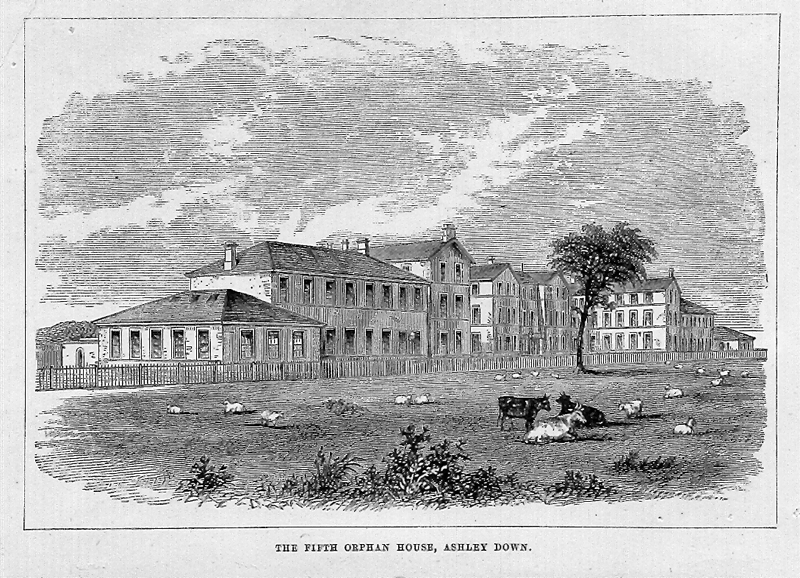
Subsequently Jane herself moved to Bristol; and when Cecil came to join the Army, after the outbreak of war, he enlisted in Bristol.
Service
Cecil's service papers have not survived. He joined the 1/6th Battalion of the Gloucestershire Regiment. This was a Bristol-based Battalion, with its origins in the Territorial Force. His service number (which was first 2950, and then, when the Force was renumbered, was changed to 265680) suggests that he joined up between 1st and 5th September 1914.
The 1/6th Battalion formed first in St Michael's Hill, Bristol; then moved to Swindon, but soon after to Maldon, Essex, for their training. Together with fellow Bristolians in 1/4th and 1/5th Battalions, they formed part of the Gloucester and Worcester Brigade (144th Brigade) in the South Midland Division (48th Division) . According to his Medal Index Card, Cecil arrived in France on 31st March 1915 - though the Battalion War Diary says that the unit arrived the following day. Cecil was a member of D Company.
Their first introduction to the trenches was in the Ypres area; they moved to the Somme in July 1915, when that part of the front was taken over by the British from the French, arriving in the front line at the village of Hebuterne, to the north of the British sector. The front line ran very close to the village, which had already been strongly fortified by the French and which was further fortified by the British as the build-up to the future attack began.
The War Diary has not survived completely intact, but their routine involved periods of holding the line at Hebuterne interspersed with rest periods in divisional reserve at Couin. The line here at this time was fairly quiet and casualties at this time were low.
The routine was interrupted when C Company was required to make a surprise attack at the corner of Gommecourt Wood, which formed a small salient in the German line. The objective was:
To raid the German trenches and shelters at southeast corner of Gommecourt Wood and obtain prisoners and information as to trenches, garrison etc. Strong works are known to exist at this point.
This involved two parties of 25 men each with one officer; with another 50 and three officers in support. The raid was reasonably successful though the time needed by one party to cut very new, strong, and thick wire entanglements meant that they lost the advantage of surprise. The other party encountered low wire and was able to attack the enemy trench successfully. Casualties were low, though one man was killed and another was missing, having been sent back with a message.
The War Diary describes the German trenches, showing just how much work had gone into building the fortifications and defences along the line:
very good condition ...about ten feet deep, firing bays for 3 men each ... trenches in chalk but not boarded or bricked with large sump holes. Shelters very deep, some with spiral staircases. All appeared to be connected by underground passages to each other and back to second line ...
Indeed, the spur of woodland at Gommecourt was one of the most strongly fortified positions in the German line: according to Peter Hart "a complex interlocked system of trenches and communications was centred on [a position called] the Maze lying to the east side of the village, while three further additional defensive switch lines isolated the whole salient in the event of [any breakthrough]".
There were as yet no plans for the summer offensive, but the Gommecourt salient eventually was identified as the location of a diversionary attack to try to produce an element of tactical surprise in the overall plan.
Meanwhile, the Glosters attempted another raid in January at Gommecourt, though fog made them call it off; but a rescheduled bombing attack on 1st February, carried out by one officer and ten NCOs and men, was successful in meeting similar objectives.
In early March, they were offered a slight change of scene, moving to a sector of the line a little further north. Small-scale British attacks of this nature had raised the tempo along the line, and during the night of 18th/19th March they were raided themselves. They sustained several casualties - the War Diary reported:
2.0am F Sector: enemy bombarded very heavily wire at K23d5.7 (sheet 57D parts 3&4), barraged front line, support lines, and communication trenches ... ; 2.15am gas, lachrymatory and smoke shells sent over.
About 2.20am: enemy raided three posts ... carrying off three men. Out of 24 men holding these three posts, ten were killed, three wounded and three missing. 2.20am: Platoon from support line ordered to counterattack.
2.25am: Posts reoccupied. One prisoner (unwounded) captured.
2.50am: Enemy ceased firing
3.0am: All quiet. Total casualties due to raid, 12 killed, one officer gassed, 29 OR wounded or gassed (three of which died of wounds)".
The following day they were relieved and went into billets in Brigade Reserve at Colincamps.
The War Diary for April is extremely brief but during this period one officer was killed in action and two (including the commanding officer) were off strength briefly. Nine men were wounded; three small drafts of reinforcements arrived.
May saw them back in the line at Hebuterne at the beginning of the month, followed by ten days of Company training at Beauval, along with the rest of the Brigade. The War Diary reports the rest of May as follows:
May 17th-24th: in trenches
May 25th - 31st: in bivouacs.
Casualties were very light - four men were wounded, one of whom died.
During June they were out of the line in various billets, but providing working parties, as the build up to the offensive quickened.
At some point Cecil was promoted Lance Corporal but there is (not unusually) no reference to this in the Battalion War Diary.
The Attack on 1st July 1916
The day of the great attack did not involve 1st/6th Glosters, who were held in reserve all day on the west side of Mailly-Maillet. The evening of the following day, they were under orders for an attack north of the River Ancre, near Beaumont Hamel, opposite the strongly fortified position of "Mary Redan", but the attack was cancelled and they went back to their bivouacs at Mailly.
After two days, they were called forward to attack slightly further north, opposite Mark and Matthew Copses. This was the sector of the line opposite the strongly fortified village of Serre. The focal parts of the Allied line here were four copses - from south to north, Matthew, Mark, Luke and John - which on 1st July had been the points of assembly for attacking troops. Once again the attack was first postponed and then cancelled.
On 6th July, overnight, B Company attempted a raid on the German front and second line between Matthew and Mark Copses. Two parties, each a platoon strong, left the front line at 1.30am. Although the first German line was damaged, both it and the second line were strongly held. B Company was hit with grenades, rifle fire and machine guns; and a Minenwerfer and several Mortars opened fire on the British front line. The report of the raid states that "Watching from Battalion Observation Station, the German line appeared to be strongly held and well organised". Lt Col Micklen, the Commanding Officer, observed that "parties of the strength sent out could [not] possibly have penetrated the German line in the face of the resistance offered".
As this indicates, the attack of 1st July had done virtually nothing to dent the very strong German defences in this sector.
In the circumstances, it is perhaps surprising that casualties in the raiding party were seven wounded, though there were also casualties back in the British front line from the shelling.
The Battalion went back to billets at Courcelles on 9th July but D company's mess was shelled and two mess stewards were wounded.
Death
The demonstrably still strong defences of the German positions around Serre does not seem to have deterred anyone on the British side from ordering a repeat performance. When the Battalion went back into the front line opposite Serre on 13th July, it was D Company's turn to lead another raid between Mark and Matthew Copses, "to penetrate the enemy's front line and to take prisoners ... alive or dead". This was to be carried out "in conjunction with other operations" - the overall offensive was renewed in the south, where there had been some success on 1st July.
The Battalion War Diary includes the detailed instructions for the raid:
Formation: 2 officers and 45 men, one officer leading and one officer in rear. To move in fours. Leading officer and 30 men to cross enemy trench at southern corner of enemy strong point, then to wheel to left along back of enemy trench. When they are behind the portion of trench selected they are to turn towards home, drop into enemy trench, clear it, bomb the shelters and then return to our line. These 30 men to consist of 10 bayonet men in fatigue dress with rifle and fixed bayonet and 20 bombers carrying 6 (no 5) grenades each (in pockets) and bayonet or bludgeon.
Remaining officer and 15 men to remain at point of entry. Bombing groups of two bayonet men and 4 bombers to move 15x down enemy trench to right to prevent any attempt to bomb up from the flank. Remaining 9 men to remain at point of entry to take over prisoners and form small reserve of bombs. The party will consist in all of 1 officer, 6 bayonet men in fatigue dress with rifle and fixed bayonet and 9 bombers with bag of 10 (no 5) grenades each and bayonet or bludgeon.
The telephone codes to report the raid's progress were:
Raiders have left our trenches: Apple
Raiders have returned to our trenches: Peach
Raid success: Strawberry
Raid failure: Medlar
Prisoners unwounded: Plum (with numeral to denote number secured)
Prisoners wounded: Cherry (with numeral)
Enemy corpses brought in: Banana (with numeral)
The report of the raid by Lt Col Micklen, the Battalion's commanding officer, indicates that "medlar" rather than "strawberry" was the result. There were no plums, cherries or bananas.
As this is most probably the action in which Cecil lost his life, it is given here in full:
Party left our trenches at 11.5pm led by 2nd Lt C H Carruthers. They crawled to within 20x of enemy trench. This took some time as the moon was bright and they could see parties at work on the enemy wire. They were challenged when within 20x of German wire but subsequent events point to them having been spotted before this. When they were challenged Carruthers gave the order to charge and he with 4 or 5 others rushed the trench. Lt Carruthers and two or three men succeeded in crossing the trench which was quite unprotected with wire at this point. They found that the rest of the party had not followed and after bombing the trench retired under a very heavy fire. Lt Carruthers got back but some of his men are believed to be missing.
Just as Lt Carruthers gave the order to charge a strong enemy party came out from the trench and advanced against the left flank of our party. Instead of following Lt Carruthers the majority of his party engaged these men with bombs and are certain they inflicted casualties. If they had done as ordered and followed Lt Carruthers there is little doubt that he would have been able to cut off this hostile party and made a considerable bag. As it was they engaged themselves in a bomb fight in the open in which the officer in rear seems to have been unable to control them while Lt Carruthers was left quite unsupported on the far side of the enemy trench.
The Sergeant who was with Lt Carruthers was badly wounded and 3 Corporals and men who crossed with him have not yet come in.
Lt Carruthers reports that
1) Wire on S Corner of strong point at K29b23 is non-existent
2) The trench here is full of water, he fell in on his way back and went in up to his neck
3) Bombs were thrown from behind the parados and also from pits about 16x in rear of the parados
4) The enemy had strong parties out all along his wire. This probably accounted for his sparing use of flares
5) What flares were fired came from his second line
6) As soon as our party charged red rockets were fired and the enemy produced a bad barrage of shrapnell over our front line (Red flares were also noticed when raiding parties on right and left became engaged)
7) Enemy used MGs from his second line
Enemy fired several minnenwerfer from Serre into Lore Copse and opened a fairly heavy rifle and MG fire. Five rounds gunfire from a battery on each flank of the raided point kept their heads down after it had been fired three times.
In my opnion the raid probably inflicted considerable casualties on the enemy but failed in its objective owing to the men of the party not following instructions when they engaged the party on their left instead of following their officer. I [that is, Lt Col Micklen] think 2nd Lieut Carruthers C H did extremely well and was unlucky not to have made a success of the raid.
Cecil appears to have been one of those missing after the raid, as his death was later "officially accepted as on 13th July 1916", according to the Soldiers' Effects Register.
Commemoration
Cecil is one of more than 72,000 officers and men commemorated on the Memorial to the Missing of the Somme at Thiepval.
In Dartmouth, he is commemorated on the Town War Memorial.

Sources
The War Diary of 1/6th Battalion Gloucestershire Regiment is available for download from The National Archives, fee payable, reference WO 95/2758/2
The Somme by Peter Hart, publ. by Cassell 2006
The Gloucestershire Regiment 6th Battalion, service numbers
Information Held on Database
| Surname: | Brown |
| Forenames: | Cecil Alfred |
| Rank: | Lance Corporal |
| Service Number: | 265280 |
| Military Unit: | 1/6th Bn Gloucestershire Regiment |
| Date of Death: | 13 Jul 1916 |
| Age at Death: | 20 |
| Cause of Death: | Killed in action |
| Action Resulting in Death: | Battle of the Somme |
| Place of Death: | Serre, France |
| Place of Burial: | Commemorated Thiepval Memorial |
| Born or Lived in Dartmouth? | Yes |
| On Dartmouth War Memorial? | Yes |
| On St Saviour's Memorials? | No |
| On St Petrox Memorials? | No |
| On Flavel Church Memorials? | No |
| In Longcross Cemetery? | No |
| In St Clement's Churchyard? | No |
| On a Private Memorial? | No |
| On Another Memorial? | No |















